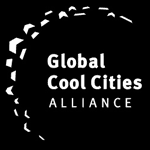Global Cool Cities Alliance
The challenge:
When the temperatures rise, densely populated cities experience an “urban heat island effect” caused by urban development and waste heat due to additional energy use. As a result, these metro areas become significantly warmer than the surrounding areas. As our climate warms, temperatures in these urban heat islands are climbing, leading to increased energy consumption for active cooling and higher green house gas emissions, which in turn both contribute to global warm and climate change. It is a vicious cycle, and can compromise human health and comfort (particularly for seniors and children), impair water quality, and damage surrounding ecosystems. For example, hot pavement and rooftop surfaces directly heat stormwater runoff, which then raises water temperatures in surrounding streams, ponds and lakes. These stressors can be fatal to aquatic life in these important watersheds, including fish, turtles, birds, and the food sources on which they depend.

What can be done?
Urban planning and design that incorporates more “cool” infrastructures (e.g. white roofs and pavements) and green infrastructure (e.g. trees, parks, and rooftop gardens) can dramatically reduce the effects of urban heat islands.
How Global Cool Cities Alliance is meeting the challenge:
The Alliance works in partnership with cities and other stakeholders, giving them the tools and support they need to identify, customize and implement successful policies and programs to lower urban heat by harnessing the benefits of cool surfaces. At the forefront of best practices, the Alliance’s key recent initiatives include:
- One Million Cool Roofs Challenge: A first-of-its-kind, $2 million USD initiative to accelerate the transformation to cool surface in places that need it most.
- Los Angeles Urban Cooling Collaborative: Helping to demonstrate the benefits of a cooler Los Angeles as a model for other cities
- South Africa Energy Efficiency and Renewable Energy Exchange: A regularly-updated platform for sharing information on initiatives related to the growth of markets for efficient, clean, and sustainable technologies in South Africa.
Global Cool Cities Alliance also created and hosts the Cool Roofs and Cool Pavements Toolkit website.





